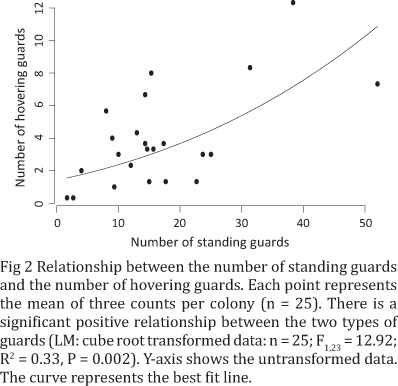The stingless bee Tetragonsica angustula (Latreille) is the only social bee known that has two different types of nest entrance guards. As in other stingless bees and the honey bee one type stands on, in or near the nest entrance. The second type, so far only known in T. angustula, hovers near the nest entrance. In order to gain further understanding of this unique situation we studied guarding behaviour in both types of guards. Using marked bees, we found that individual worker bees guarded for a long time, up to 20 days, relative to their short, average c. 21 day, lifespan. Relatively few, 33%, individually marked guards were seen performing both types of guarding. The others only acted as standing guards. The bees that did perform both types did so over similar periods of their life. Hovering bouts were 57 min long, interrupted by breaks inside the hive of a few minutes (3.3 ± 1.5 min). Standing bouts were slightly longer (74 min) and also interrupted by short breaks (7.82 ± 6.45 min). Human breath, mimicking a vertebrate intruder, caused the guards to retreat into the nest rather than to attack the intruder. Some colonies protected themselves against intruders by closing the entrance during the night (32% and 56% of colonies during two nights). In summary, our results indicate that nest entrance guarding in T. angustula involves division of labour between the two types, in which most guarding individuals only act as standing guards.
Division of labour; Jataí; Meliponini; guarding behaviour




